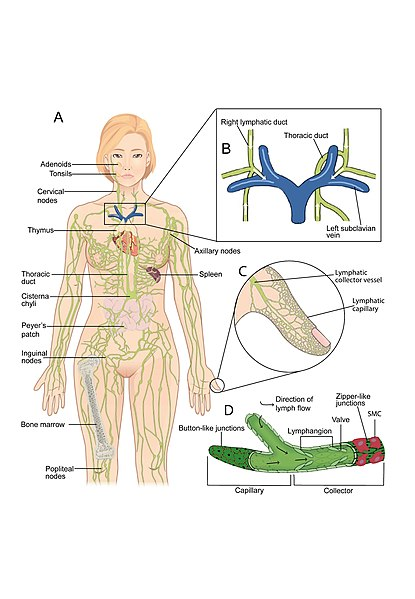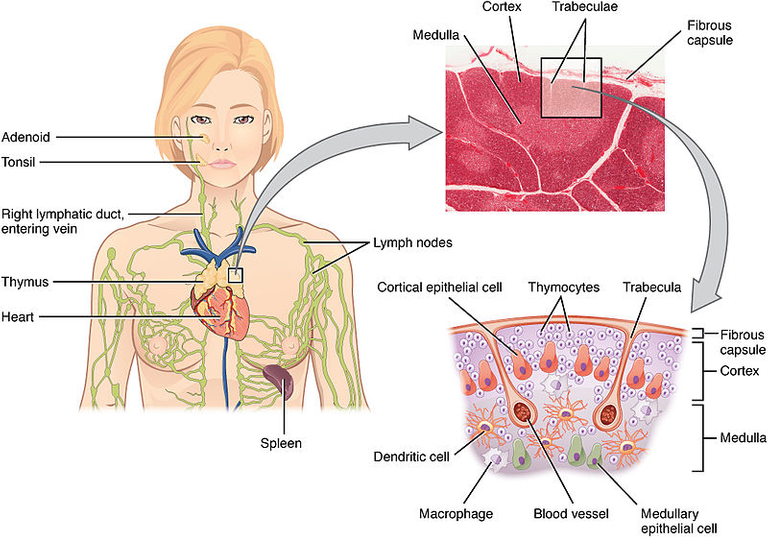Pathogens that, without the immune system, would cause illness or even mortality are neutralized or eliminated by the body's intricate network of cells and organs known as the immune system. The lymphatic system and the immune system are so intricately linked in most people that distinguishing between them is nearly impossible. The lymphatic system is made up of a web of veins, lymph nodes, and other lymphatic structures. Its main role is to filter the blood and bring any potentially harmful substances it finds to the liver for elimination. There is a vast network of connections between these crucial organ systems, as evidenced by the enlargement of lymph nodes in reaction to an infection and the movement of lymphocytes through lymphatic vessels.
Multiple Functions of the Lymphatic System
The drainage of fluids from tissues and their redistribution into the vascular system are two of the lymphatic system's primary functions. When blood pressure is too high, fluid leaks out of the capillaries and builds up in the interstitial area. That which exists between cells in a tissue is called the interstitial area. Twenty litres of plasma are released into the interstitial region of the tissues in humans every day as a consequence of capillary filtration. After being filtered out of the blood and into the interstices between organs, this filtrate is referred to as interstitial fluid. Seventeen gallons of this amount are reabsorbed directly by the blood vessels. However, what should be done with the remaining three gallons? At this stage, the lymphatic system becomes important. The fluid that has been removed from the body in excess is returned to the circulatory system via a system of arteries, ducts, and stems. Once it has been processed by the lymphatic system, the intercellular fluid is known as lymph. Any damage to the lymphatic system, whether caused by cancer cells blocking the system or by an accident destroying the lymph vessels, causes protein-rich interstitial fluid to collect (and sometimes "back up") in the tissue spaces. Numerous health problems may arise as a result of this. An excessive buildup of fluid, known as lymphedema, can have serious effects on a patient's health.
Lymphatic vessels evolved as an efficient way to transport immune cells during the evolution of the vertebrate immune system. In addition, the fat-soluble vitamins and dietary lipids absorbed in the digestive process are transported by this mechanism.
Lymph nodes serve as crucial staging areas for the formation of immune responses and as conduits for immune cells returning to circulation from the interstitial spaces. This occurs due to the closeness of lymph nodes to lymphatic vessels. Lymph nodes are tiny bean-shaped structures that can be found all over the lymphatic system.
How the Lymphatic System Works From the Inside
Lymphatic vessels develop from capillaries, which are the first open-ended veins in the body. Lymph flows from these capillaries into lymphatic vessels of increasing size, which eventually discharge into the bloodstream via a system of ducts. The lymph travels through the lymph nodes, which are clustered in the groin, underarms, neck, chest, and belly. The lymph moves through these nodes en route to its ultimate target. Humans typically have between 500 and 600 lymph nodes located in various parts of the body.
In people, lymph is not actively pumped by the heart, but rather is pushed through the vessels by breathing and the contraction of skeletal muscles during movement. This is a major distinction between the human lymphatic system and the circulatory system. Semi-lunar valves are one-way valves found in lymphatic vessels that keep lymph flowing toward the heart. Located in the neck at the meeting point of the jugular and subclavian veins, lymphatic ducts carry lymph from lymphatic capillaries to lymphatic arteries and on into the circulatory system.
Lymphatic System Capillaries
Lymph fluid originates in the interstitial space and is transported to the lymph nodes via lymphatic vessels, which are similar to arteries. Besides being known as the terminal lymphatics, this network of vessels goes by a few other names. These blood arteries are found in the body's soft connective tissues, where they are interspersed with arterioles and venules. They permeate the majority of the body's tissues. The cornea, bone marrow, bones, molars, and central nervous system are the only known exceptions to this norm. These areas of the body also lack lymphatic arteries.
Lymphatic vessels are the lymphatic system's exit points. They're produced by endothelium cells arranged in a single layer and measure exactly one cell thick. Since their cell layers meet, interstitial fluid can easily enter them. When intra-interstitial pressure is low, endothelial "flaps" shut to block "backflow." When the interstitial pressure increases, the gaps between the cells dilate and allow the fluid to pass through. Lymphatic fluid can penetrate the capillaries and move through the lymphatic system because collagen filaments anchor the capillaries to surrounding structures. Since the interstitial pressure has risen, the filaments are drawing on the endothelial cell flaps, widening the openings and facilitating fluid entry.
Lymphatic capillaries, or lacteals, can be discovered in the small intestine. These capillaries are crucial for the entry of lipids and lipid-soluble vitamins into the food into the bloodstream. The lacteals in the small intestine are responsible for producing chyle, a milky fluid produced when dietary triglycerides mix with other lipids and proteins. The small intestine is the site of this procedure. After that, the chyle travels through the capillary system, into the liver, and then into the bloodstream.
Larger lymphatic nodes, arteries, and ducts

Wikipedia
Larger lymphatic arteries receive lymph from the lymphatic capillaries and are similar to veins in structure and function (three tunics and valves). Larger lymphatic arteries like these are responsible for draining lymph fluid away from lymph nodes. Lymphatic vessels take on a beaded appearance because each one-way valve produces a bulge in the vessel wall. The locations of these valves are near together.
The lymphatics, both superficial and deep, eventually merge into bigger vessels called lymphatic trunks. The right lymphatic duct collects lymph from the right side of the head, the right side of the chest, and the right upper leg, and then empties it into the right subclavian vein. The right half of the body is affected. The left subclavian vein receives blood from the rest of the left side of the body via the bigger thoracic duct. As a rule, this affects the person's left side. The thoracic duct begins in the cisterna chyli, a sac-like chamber that receives lymph from the lower abdomen, pelvis, and lower extremities via the left lumbar trunk, the right lumbar trunk, and the intestinal trunk. Just below the diaphragm is the beginning of the thoracic duct.
The lymphatic system, in general, is not perfectly uniform. The right lymphatic duct only carries lymph that has its origin in the top right quadrant of the body. Lymph from the rest of the body gathers in the thoracic duct and then travels through the remaining lymphatic trunks to the circulatory system. The shallow lymphatic vessels, which are located in the dermis and epidermis, and which are also known as veins, usually follow the same routes as venous blood vessels, while the deep lymphatic vessels, which are located in the viscera, follow the same routes as arterial blood vessels.
References
- What are the organs of the immune system? - InformedHealth.org - NCBI Bookshelf. (2020, July 30). What Are the Organs of the Immune System? - InformedHealth.org - NCBI Bookshelf. https://www.ncbi.nlm.nih.gov/books/NBK279395/
- Anatomy of the Lymphatic and Immune Systems | Anatomy and Physiology II. (n.d.). Anatomy of the Lymphatic and Immune Systems | Anatomy and Physiology II. https://courses.lumenlearning.com/suny-ap2/chapter/anatomy-of-the-lymphatic-and-immune-systems/
- Lymphatic system: Definition, anatomy, function, and diseases. (n.d.). Lymphatic System: Definition, Anatomy, Function, and Diseases. https://www.medicalnewstoday.com/articles/303087
- 19: Lymphatic and Immune System. (2020, May 6). Medicine LibreTexts. https://med.libretexts.org/Bookshelves/Anatomy_and_Physiology/Human_Anatomy_(OERI)/19%3A_Lymphatic_and_Immune_System
- C. (n.d.). Lymphatic System: Parts & Common Problems. Cleveland Clinic. https://my.clevelandclinic.org/health/articles/21199-lymphatic-system
- Lymphatic system. (n.d.). Lymphatic System: Definition, Anatomy, Functions | Kenhub. https://www.kenhub.com/en/library/anatomy/lymphatic-system
- R.N., M. B. (2017, August 8). Lymphatic System Anatomy and Physiology: Study Guide for Nurses. Nurseslabs. https://nurseslabs.com/lymphatic-system-anatomy-physiology/



This is really educating
Thank you dear buddy for stopping by
Thanks for your contribution to the STEMsocial community. Feel free to join us on discord to get to know the rest of us!
Please consider delegating to the @stemsocial account (85% of the curation rewards are returned).
You may also include @stemsocial as a beneficiary of the rewards of this post to get a stronger support.
The lymphatic system is actually large as its vessel is found all round in the body system. Its function is highly needed in the body as it serves as the drainage system of the body. Just imagine our roads without a drainage system, oh stagnated water would be everywhere and the place will have its own offensive smell that would be unbearable for humanity. Lymphatic system can also be seen as the drainage system of the body. Thank you for coming up with this wonderful piece of writing. It will definitely help the space. Thank you
I love how you linked the road drainage to the lymphatic vessels of the body system. And thanks so much for your time
You're welcome ☺️☺️☺️